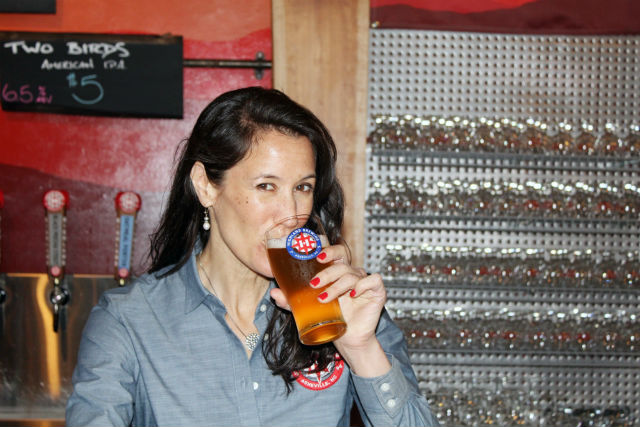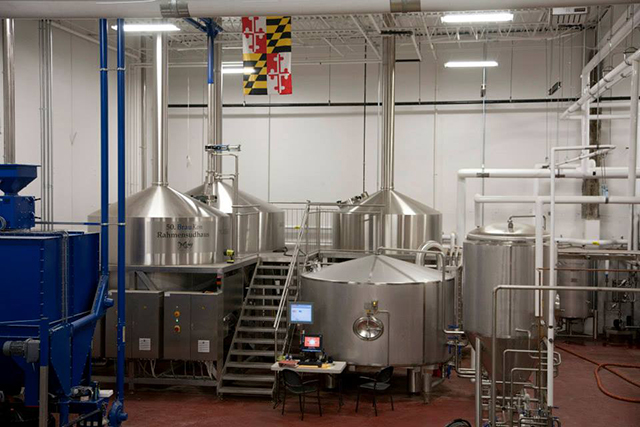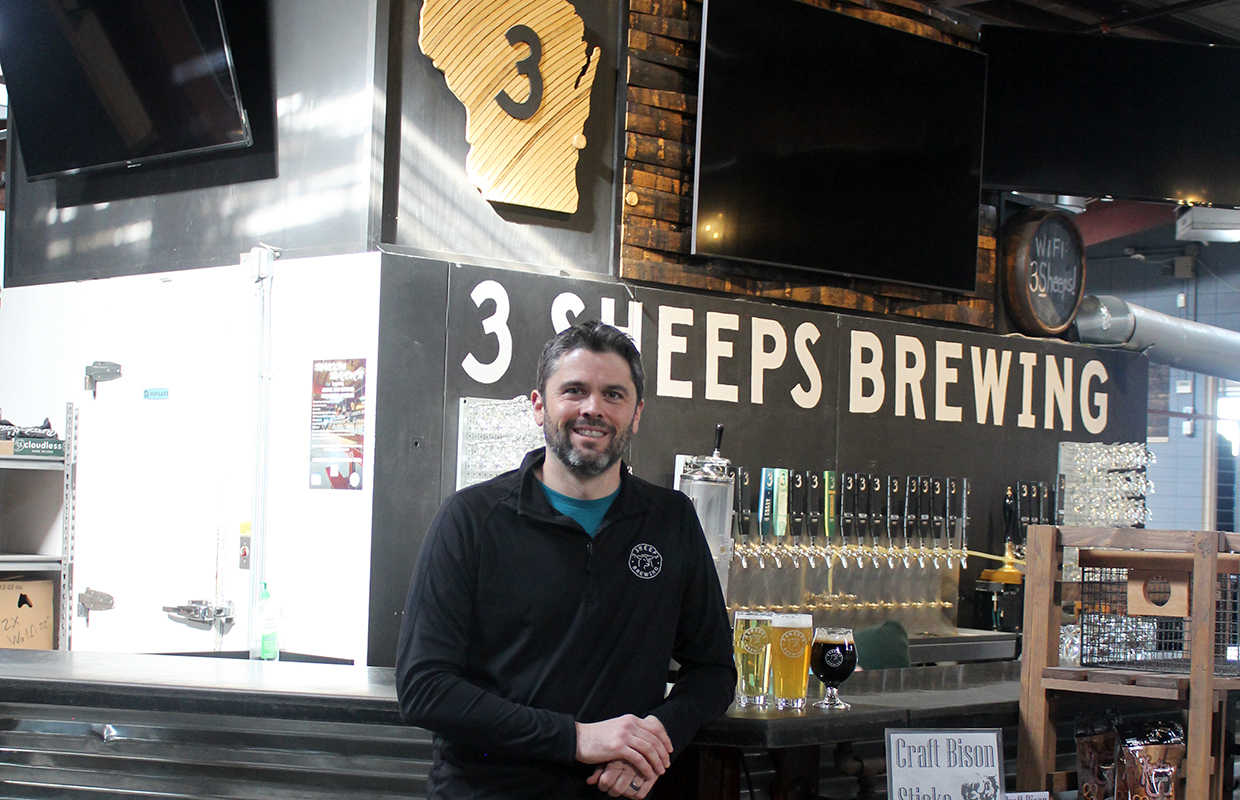
Change isn’t easy, but it can be necessary. For Highland Brewing, the second-generation had already taken over. But now Leah Wong Ashburn, who took the brewery’s reins as the company’s president from her father — founder Oscar Wong — in 2015, has helped shape what she hopes can be the future of the nearly quarter of a century-old Asheville, North Carolina institution.
“We don’t want to be someone’s father’s beer, right? If you don’t change then your time is going to come,” she said. “We aren’t going. We have so much energy, and life and creativity left.”
Founded in 1994, the brewery made 43,000 barrels in 2017, which placed them 72nd in the country and the 10th largest in the South by volume. In the brewery’s begining, Oscar Wong wanted to honor and portray the Scottish heritage of the area they called home in the Appalachians of North Carolina. Tartan on the bottles with a bagpipe holding bearded man was the crest of Asheville’s first craft brewery.
Yet, when polled, consumers, retailers and even the Highland staff never thought “Scottish” when asked what Highland was all about.
“One hundred percent of our brand said Scottish and except for the word Gaelic (one of the brewery’s brands), nothing in our beer says Scottish in style or name,” Wong Ashburn noted. “So it had really created a divide and the fact that we look the same for 24 years kind of told people that we were doing the same thing. And we’re not.”
So Wong Ashburn looked to close the divide she felt that the brand was creating.
“We wanted to clear out the confusion … and close the divide between the beer and the brand,” she said. “We did that by focusing on the fact that we’re Asheville’s pioneering brewery. We’re still creating a path, we’re still doing great things and Asheville is our home.
“Asheville … pioneers, I love clarity and that’s what we have now.”
Highland debuted its new look in February of 2018 after working with Austin, Texas’ Helms Workshop. The new imagery includes the Blue Ridge Mountains, a suggestion of a pioneer’s compass and a clear message on the product that Highland is Asheville’s first craft beer.
That came on the heels of a slight brand refresh in late 2015 when the brewery also added canned products. The most radical change has been to the brewery’s logo, which goes from the Scottish man to a compass-like cross with a white “H” in the middle, Highland’s name around it and a multi-colorful background.
“The consistent thing is that we really believe that Highland is a brand and we want people to see that really clearly and know that it is something that they can really trust,” Wong Ashburn said. “Color blocking works really easy to help people to identify the beer style within a brand. Shapes and colors. You can simplify things for people. I think that is a great thing.”
With the internal branding team Wong Ashburn said she tried to make it seven or less people.
“Well, I failed there with 10 people,” she said. “So we had several meetings with Helms and we would either chat electronically or they would visit and all of us were interviewed and they sorted through all that information to get to a core positioning statement for our voice.
“They showed us the two first ideas, we explained what we liked and didn’t and after that it became me and [Marketing Coordinator] Molly McQuillan.”
To do away with the larger branding team, Wong Ashburn explained to them with two pictures: a horse and a camel.
“One was a beautiful quarter horse and it was shiny, with a beautiful tail, ears pricked,” she explained. “And I said, we can all agree that this is a beautiful animal. If you designed this animal by committee you get this: and I showed this crazy one-hump camel. Which in comparison to a horse is kind ugly. That’s what you get when you design by committee. So you have to make it small, make quick decisions and get it back out there again.”
It’s a small sample size, but a six-week marketing campaign helped introduce the new look to consumers. Wong Ashburn said brewery reps and distribution partners traveled around for a month and a half to touch as many as 2,000 accounts in 15 markets.
“One of their folks and one of our folks in a car … going around two to three days in each market, which made it very, very successful,” she said. “We got to tell the story personally, and that’s the best way to do it. Distributors also got to hear us tell it, which is the best way for them to hear it as well.
“I got to join in on a lot of those. And it was six hellish weeks, but it was successful. Our sales team crushed it. We did that a lot and we can call it that a success and now we have to look at what sticks. What happens in the rest of Q2, Q3 and Q4? We’ll see.”
One of the things that encouraged Highland to do the launch was hearing from their distributors.
“[They would say] that there was just one element holding us back,” Wong Ashburn said. “They were like, ‘you know, you’ve got all these new beers, and that’s great. But you’re not getting the full reaction to them because the brand looks like same.’ So that was one of the ways that helped push us to this change. Retailers and distributors have reacted wonderfully to it.”
Wong Ashburn said at times, the past year of rebranding and refreshing the look has been ‘gut-wrenching.’
“Screw up or not, it’s still mine. But I love it,” she said. “My dad birthed this company in 1994 and we have relished the reaction from the Asheville community and the beer community. And all of a sudden I’m going to radically change the brand? That’s scary as hell and it’s not like there’s one answer. … It is still scary because it was so radical of a change. But the cost of not doing it was greater than the cost doing it. I feel we have set ourselves up for the clearest message for consumers for years to come.”
The process started in earnest at the 2017 Craft Brewers Conference in Washington DC. Wong Ashburn joked that the process started before that, but it basically came down to a small group talking and then kicking the can down the road.
But at the 2017 CBC, Wong Ashburn and her team went around to every branding company that was there.
“I got recommendations and called some industry friends — even friends of people on our staff,” she said. “From there we did proposals with some people and got more serious by talking to some over the phone and then narrowing it down. It ended up with us working with Helms.
“They have a tie to North Carolina, which was important to us too.”
That tie being that Helms owner, Christian Helms, spent nearly every summer of his life in the Asheville area of Black Mountain. He knew of Highland well.
“We wanted some kind of understanding of us,” Wong Ashburn said. “And we wanted them knowing not only craft beer but heritage craft beer. There is not a ton of that — of people that have rebranded in our young industry. … They had worked with some of the fastest growing companies and also in particular, a bigger heritage company with a complete refresh.”
When Wong Ashburn met with Helms she said she knew there was a connection that would work.
She pointed out that using an outside company helped streamline where Highland would go in terms of looks. Nothing they had thought of came out of initial concepts internally.
Instead of giving Helms a concept, the Texas company asked for verbage of what Highland meant. That’s where Wong Ashburn noticed consumers, retailers and even her own staff where not saying “Scottish” when asked what Highland mean to them. That’s how the disconnect became apparent.
“Their job is to mish-mash all of our inputs,” she said. “They interviewed people in Asheville — people that that don’t work at Highland.
“Retailers, distributors, people in and out of the market and our own staff.”
At the same time, the brewery had a team to discuss branding, including new and older tenured employees.
“I really needed our next great statement,” she said. “So with their help and with all kinds of research from a Nielsen study that was huge on a big scale. We wanted people that don’t know us, down to our social media and e-newsletter — our friends survey — down to our own staff and I asked everyone on staff to tell me words they think of when I say Highland and it merged unbelievably well with it what Helms was coming back with.”
Since they began as a distribution brewery in the 90s, and the strategy for many breweries now is to focus on their home market with deeper distro and selling its beer in its taproom, Highland is using this refresh as a way to focus on the home base as well, which is tucked just outside of downtown Asheville on 40 acres.
“Now, maybe [a brewery] will get into distribution. It’s not a good time to get into distribution now,” Wong Ashburn said. “I am thankful that we are going in the opposite direction. We have so much that we can do better at our hilltop [location], where we got this huge building with 40 acres. We’re going to build trails. We’re going to build more of an experience.
“We take up more than half of that building but we have very little frontage. So there’s so much that can be done to make it where people can some spend the day.”
It’s going to be beer first but it’s also going to be a place to take a walk in the woods, she noted.
“That’s what I love. This brand is going to be a reflection of me — which really sounds like strong words,” she said. “But if I am putting my mark on it — which my dad’s encouraged me to do since Day One. I really have tiptoed around that until now and now I’m understanding and getting more comfortable with that. So I can’t wait to do more things at the brewery. And I think that will expand out into the market to show we are in an amazing place in Asheville. I want [consumers] all to to come to Highland and then buy the beer when they go back home.”
The brewery closed for four days to renovate the taproom and transform into the new look.
“Four days was not quite enough time to do everything we want to do,” Wong Ashburn said with a laugh. “But we’ve got the major stuff done. We really changed the look and feel and it was so much fun to do that too because putting in good lighting and more comfortable seating — some cozy areas — was important.
“I want to sit on something squishy, we never had something like that. That’s what I wanted to do, so why not add it?”
Branding was added to the shipping containers which double as offices in the backside of the taproom with painting done by a local artist.
“We are really proud to have another connection to the community that way,” she said. “Decent signage is expensive, so we are a third of the way through that.
“But when we opened up on that Friday night it was branded out … it’s really really exciting. We’re going to keep doing more stuff all the time.”
The on-site piece is really important to Wong Ashburn.
“The industry is in so much change but I feel so positive about the changes that we’ve made and what we can still do,” she said. “On- and off-site location service is important because our people are so good and because we’re growing in a way that feels really authentic to us that we can still speak on that and act on.”
Adding to the future legacy that Wong Ashburn is creating includes new projects.
Although she didn’t divulge details, the emergence of popular styles like hazy IPAs and barrel-aged projects have shown that even older entities in the craft beer world can capitalize on trends that have been set by an ever-searching base of consumers.
“We have great beer programs that haven’t come out yet that are cooking away,” she explained. “We are so excited about what we have internally, but we aren’t going to release them until we are okay with the high-level of quality we have.
“But I’m OK with that, because we can then sell it and speak to it in a way that meets the quality that we do everything else. You don’t want to do it early and screw it up and say, oops, we tried.”




2 Trackbacks / Pingbacks